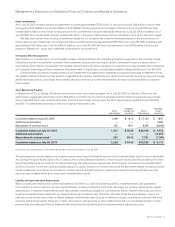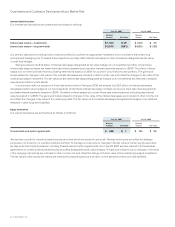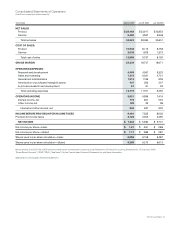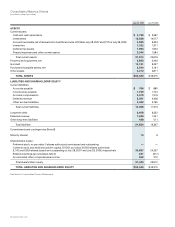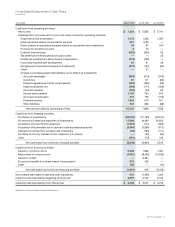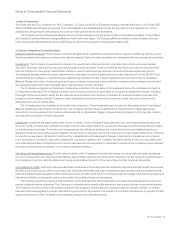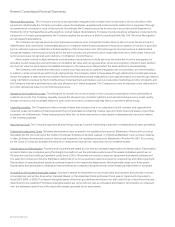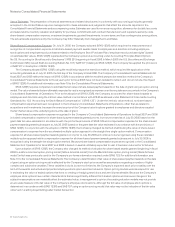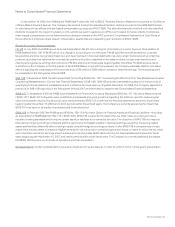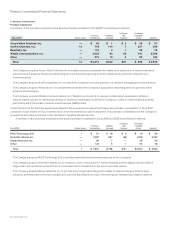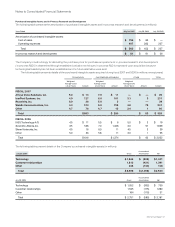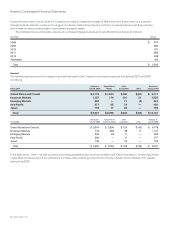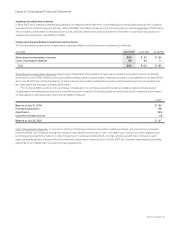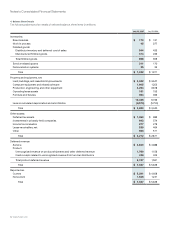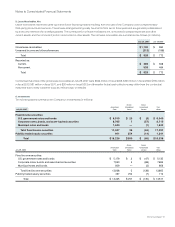Cisco 2007 Annual Report Download - page 48
Download and view the complete annual report
Please find page 48 of the 2007 Cisco annual report below. You can navigate through the pages in the report by either clicking on the pages listed below, or by using the keyword search tool below to find specific information within the annual report.
2007 Annual Report 51
Notes to Consolidated Financial Statements
Impairment of Long-Lived Assets Long-lived assets and certain identifiable intangible assets to be held and used are reviewed for
impairment whenever events or changes in circumstances indicate that the carrying amount of such assets may not be recoverable.
Determination of recoverability of long-lived assets is based on an estimate of undiscounted future cash flows resulting from the use of the
asset and its eventual disposition. Measurement of an impairment loss for long-lived assets and certain identifiable intangible assets that
management expects to hold and use is based on the fair value of the asset. Long-lived assets and certain identifiable intangible assets
to be disposed of are reported at the lower of carrying amount or fair value less costs to sell.
Income Taxes Income tax expense is based on pretax financial accounting income. Deferred tax assets and liabilities are recognized for the
expected tax consequences of temporary differences between the tax bases of assets and liabilities and their reported amounts. Valuation
allowances are recorded to reduce deferred tax assets to the amount that will more likely than not be realized.
Computation of Net Income per Share Basic net income per share is computed using the weighted-average number of common shares
outstanding during the period. Diluted net income per share is computed using the weighted-average number of common shares and
dilutive potential common shares outstanding during the period. Dilutive potential common shares primarily consist of employee stock
options, restricted stock and restricted stock units.
Statement of Financial Accounting Standards No. 128, “Earnings per Share,” requires that employee equity share options, nonvested
shares, and similar equity instruments granted by the Company be treated as potential common shares outstanding in computing diluted
earnings per share. Diluted shares outstanding include the dilutive effect of in-the-money options which is calculated based on the average
share price for each fiscal period using the treasury stock method. Under the treasury stock method, the amount the employee must pay
for exercising stock options, the amount of compensation cost for future service that the Company has not yet recognized, and the amount
of tax benefits that would be recorded in additional paid-in capital when the award becomes deductible are assumed to be used to
repurchase shares.
Foreign Currency Translation Assets and liabilities of non-U.S. subsidiaries that operate in a local currency environment, where that local
currency is the functional currency, are translated to U.S. dollars at exchange rates in effect at the balance sheet date, with the resulting
translation adjustments directly recorded to a separate component of accumulated other comprehensive income. Income and expense
accounts are translated at average exchange rates during the year. Translation adjustments are recorded in other income, net, where the
U.S. dollar is the functional currency.
Derivative Instruments The Company recognizes derivative instruments as either assets or liabilities and measures those instruments
at fair value. The accounting for changes in the fair value of a derivative depends on the intended use of the derivative and the resulting
designation. For a derivative instrument designated as a fair value hedge, the gain or loss is recognized in earnings in the period of change
together with the offsetting loss or gain on the hedged item attributed to the risk being hedged. For a derivative instrument designated
as a cash flow hedge, the effective portion of the derivative’s gain or loss is initially reported as a component of accumulated other
comprehensive income and subsequently reclassified into earnings when the hedged exposure affects earnings. The ineffective portion
of the gain or loss is reported in earnings immediately. For derivative instruments that are not designated as accounting hedges, changes
in fair value are recognized in earnings in the period of change. During fiscal 2007, 2006, and 2005, there were no significant gains or losses
recognized in earnings for hedge ineffectiveness. The Company did not discontinue any hedges because it was probable that the original
forecasted transactions would not occur.
Consolidation of Variable Interest Entities The Financial Accounting Standards Board (FASB) issued FASB Interpretation No. 46,
“Consolidation of Variable Interest Entities” (“FIN 46”), in January 2003. FIN 46 requires that if an entity is the primary beneficiary of a
variable interest entity, the assets, liabilities, and results of operations of the variable interest entity should be included in the consolidated
financial statements of the entity. FASB Interpretation No. 46(R), “Consolidation of Variable Interest Entities” (“FIN 46(R)”), was issued in
December 2003. The Company adopted FIN 46(R) effective January 24, 2004. For additional information regarding variable interest
entities, see Note 8 to the Consolidated Financial Statements.
Minority Interest The Company consolidates its investment in a venture fund managed by SOFTBANK Corp. and its affiliates
(“SOFTBANK”). As of July 28, 2007, minority interest of $10 million represents SOFTBANK’s share of the venture fund.


